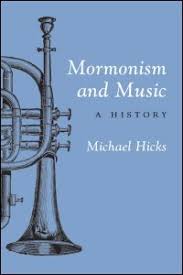Articles/Essays – Volume 24, No. 3
A Song Worth Singing | Michael Hicks, Mormonism and Music: A History
Anyone who has worked with Mormon music has likely experienced the frustration of being unable to learn much about its past —such things as composers, per formers, and institutional policy and practice. Collections of folk music, histories, and hymnals contain tantalizing hints of stories to be told, but until now, no one has attempted to draw all of the information together into a coherent narrative. Michael Hicks has produced an impressive study and in the process has shown Mormon musical history to be as fascinating and as instructive as any story in our past.
Hicks devotes half his book to the nineteenth century, when interactions between sacred and secular, and between the individual and the institution, were less strictly denned; and half to the twentieth century, when the Church has become more bureaucratic, and administration has become more centralized. Hicks’s narrative identifies three recurring themes: “the will to progress versus the will to con serve, the need to borrow from outsiders versus the need for self-reliance, and the love of the aesthetic versus the love of utility” (p. x). These themes, played out repeatedly in all phases of the Mormon drama, underlie virtually every episode of music-making over the century and a half Hicks explores, from the early community enthusiasms for band music and home-composed songs to the latest at tempts at creating a hymnbook and a policy for music in worship.
Hicks’s chronicle is immensely read able, well documented, and thorough. The notes alone would keep any reader busy following interesting side paths, and the index is complete and useful. The narrative itself sparkles with fascinating anecdotes, like the story of Levi Hancock’s fife music causing Joseph Smith’s dog to attack his own foot soldiers, fomenting a feud between the soldiers’ commander and the Prophet (p. 55); and little-known facts, like the time someone set the Joseph Smith story to the tune of “Tumblin’ Tumble weeds,” causing the First Presidency to speak against the mingling of sacred and secular styles (p. 140).
More important, however, is the perspective we gain from Hicks’s descriptions of changes in Church personnel and pol icy, differences of opinion, and musical trends, and their effects on Mormon music decade by decade. From the Church’s earliest days, the Saints have been interested in creating uniquely Mormon music, music that originates with them and expresses their values. The music they have created has ranged in style from the most esoteric academic to popular or sectarian. Likewise, Church leaders have set standards on appropriateness, ranging from allowing band music in worship ser vices in the mid-nineteenth century to having the Tabernacle Choir sing more popular music in the mid-twentieth century.
Hicks closes with a timely discussion of the way the Church has treated musics of other cultures as it has spread world wide. The current music committee should take note of the numerous times, documented here, when the academic and the ill-informed have attempted to quell what seemed to them inappropriate music for worship, disregarding both cultural differences and the passion in musical praise. We should spend less time and effort worrying about form and more lauding content. A jubilant African song of praise does not express love of God less than a somber Anglo-American hymn. Perhaps even the pop-Mormon songs we currently hear sung in breathy adolescent voices have a valid role in helping young people express their religious feelings. They are no different from past popular “gospel” songs such as “How Great Thou Art,” which, Hicks tells us, Church musical leaders fought adamantly for decades.
Mormonism and Music is a solid foundation work on which to build. Hicks has laid out the basic story, uncovering many subjects appropriate for further exploration. One potentially fertile area would be a study of the informal folk and popular Mormon music of the twentieth century to parallel the institutional side that Hicks documents here so well.
Mormonism and Music is an important, balanced, and long-needed contribution to LDS scholarship. It is incredible that no one has written such a history before. Music is basic to Mormon worship. It is also art, capable of moving its listeners at least as much as prayers and theology. As Hicks says in his introduction, “Religion and art as institutions have maintained a fundamental enmity . . . doubt less because they make similar claims and demands” (p. x). When religion and art are allied, the marriage may be rocky, but always interesting.
Mormonism and Music: A History by Michael Hicks (Urbana and Chicago: University of Illinois Press, 1989), xii, 243 pp., $24.95.


 Back to full Issue
Back to full Issue

